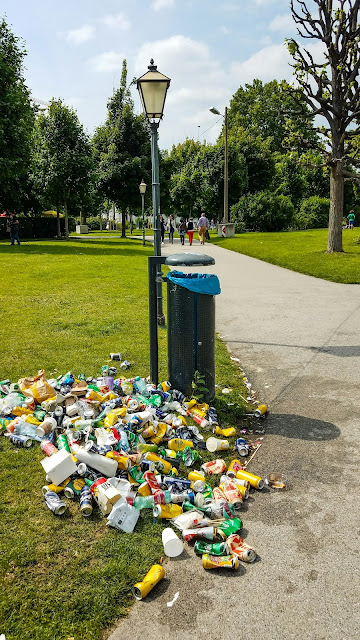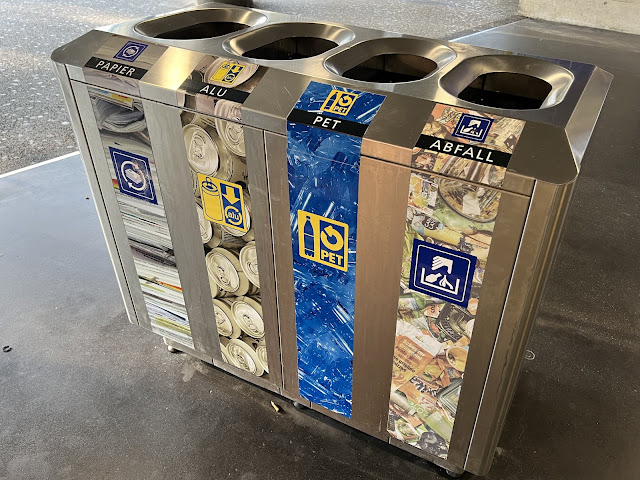 |
| Photo by Random Person on Unsplash |
Welcome back to July's UBC. This month I'm going to be talking about cultural differences between Switzerland and the USA.
Today let's talk trash!
Not to be confused with "let's trash talk", as certain provocative hockey players like to do ;-)
I may have mentioned the Swiss people's cleanliness and recycling obsession a time or two, but here we go again.
Growing up in Switzerland I had no idea that our system is somewhat unique.
In my village, ever since I can think, garbage pick-up happens on Friday.
Apartment buildings and blocks of flats have metal containers in which the bags are collected during the week and taken to the street by the janitor on Fridays.
Homeowners put the bags out individually. They will place their garbage bags with the appropriate waste stickers on them in the morning. Some people put the trash on the roadside the evening before. In many places, however, this is a bad idea because foxes and other animals get at it.
Wait a minute, what's a "waste sticker"?
We have to stick a "trash fee label" on the garbage bag and thus - in addition to the fact that we pay taxes - contribute to the disposal costs. It is also a measure to reduce waste and promote recycling. Some communities don't have stickers, but actual trash bags with the fee logo already printed on them. Unfortunately, these bags are often of poor quality, which is particularly annoying because if they tear, the money goes down the drain and you have to use another expensive bag.
How much, you ask? CHF 3 for 35 liter bag (about 10 gallons). At today's exchange rate, this corresponds to USD 3.36. For a small garbage bag!
After the introduction of the trash fee stickers, the volume of household waste fell significantly in many Swiss municipalities. According to estimates, such systems can lead to a reduction in household waste of around 20-30%. I am surprised though. I would have expected it to be more.
No wonder Swiss people have become masters at sorting waste! Many people have a compost heap in their garden where they collect organic kitchen waste.
Another "initiative" is newspaper bundling. Foreign comedians make fun of us, claiming this is a national hobby, actually more than a hobby, an art.
Why do we have to tie our paper into neat bundles?
Because "clever" people who didn't want to spend their money on litter stickers, filled paper bags with household waste, covered them with some newspaper and placed them on the street on the day of the waste paper collection.
 |
| Photo by Digital Buggu |
Waste paper collection? Yes! In large cities this happens twice a week. You put your bundles on the roadside, and employees of the municipal waste disposal service will pick them up. Out little town only has quarterly paper collection, and the work is being done either by middle school students or sports clubs - they will generate a small income for their class / club treasury.
We are in the fortunate position of having a recycling paradise about 5 km (3 miles) away. We can get rid of most of our recyclables there free of charge: PET bottles, plastic bottles, paper, cardboard, glass, coffee capsules, tin and aluminum cans, electrical products.
Back to the trash bags that are collected on Fridays though. What happens after you put them on the sidewalk?
They are collected by refuse collection vehicles and transported to a waste processing plant, which generates energy in the form of electricity and/or heat from the incineration of the waste. The remaining ash from the incineration plants is stored in special landfills. Some of this ash can be reused, for example in road construction, but the majority is safely landfilled to minimize environmental impact.All stages of waste processing are subject to strict environmental controls to ensure that no pollutants are released and that the process is as environmentally friendly as possible.
It's no wonder it's an expensive process, right?
There are a total of 30 waste incineration plants in Switzerland, and many years ago I had the opportunity to visit our local one. It was impressive to see the amounts of trash being burned! The man who showed us around the facility remarked that many residents were still too lazy to recycle. "Listen carefully," he said as the machine dropped a load of waste bags into the large collection container. There were sounds of metal and bursting glass. This explains why trash stickers only led to a 30% reduction in household waste.
This process differs from how waste is treated in most parts of North America, even if more and more recycling stations are appearing. But where does this separated waste end up?
Historically, large quantities of recycled materials have been exported to countries such as China. However, China introduced the "National Sword" program in 2018, which sets strict contamination limits for imported recyclable materials.
Following the Chinese import restriction, the US has looked for alternatives and is now exporting recycled materials to other countries such as India, Vietnam, Thailand, Malaysia and Indonesia. However, stricter rules are also being introduced there.
The net result is that some recyclable materials still end up in American landfills, where waste takes a long time to decompose. Upon researching, I was quite shocked how long:
- Food scraps: 1 - 6 months
- Paper: 2 - 6 weeks
- Plastic bottles: 450 years
- Plastic bags: 10 - 20 years
- Aluminum cans: 80 - 200 years
- Tin cans: 50 years
- Glass bottles: Indefinite time (glass practically does not decompose, it breaks down into smaller and smaller pieces)
- Rubber tires: 50 - 80 years
- Cotton fabrics: 1-5 months
- Synthetic fabrics (such as polyester): 20 - 200 years
- Electronics (e-waste): decomposes strongly; many components decompose over hundreds of years, releasing heavy metals and other pollutants.
Isn't this madness?
Let's not even start with mechanical. hydrometallurgical and pyrometallurgical recycling methods that are needed to dispose of lithium, nickel, cobalt and manganese-containing batteries from electric vehicles...
The long decomposition times of many materials underscore the need for recycling, waste prevention and the use of alternative disposal methods to minimize environmental impact.
How does trash collection and recycling work where you live?





I love the kids area and that sometimes people create art! I am shocked, too, to read how decomposition can take. The newspaper bundles are cute. :)
ReplyDeleteThat kids area is fantastic! In our town we separate recyclables from other trash. We have two different cans. Shortly before our new trash company, news went out that recyclable material sent to the recycling yards were just being thrown into regular trash because it was causing to much for recycling companies to process. There was anger. Then our new company only came by with one truck. Boy were people mad! Then we found out the truck is divided in half-one for recyclables and the other for regular trash. I’m ok with that!
ReplyDeleteThanks for sharing about recycling practices. Where I live in my apartment, we don't have recycling, and the nearest drop-off is too far away. It's frustrating not having easy access to recycling options. Your post made me think about how important it is to have better recycling options in our area.
ReplyDeleteI love the recycled whale and kids area, never to young to start teaching them. I would fit right in with the recycling! Our community had weekly trash pickup but it's for everything that fits in the can, kitchen trash, boxes, bottles, you name it and it's about $50 per month. The county also has numerous recycling centers and we have 2, both within 2 miles from my home. I have two crates in the garage, one from bottles ,cans, and paper, the other from cardboard. When they get filled I haul them to the recycling center. Kitchen trash goes all in one bag. The also have a recycling bin for clothing and shoes that when collected, the Autism association gets a donation. So that's a win win. Any other trash whether it be old batteries, fire extinguishers, wood, metal, etc, there are large dumpster for each. It's worth it to save $50 per month but it also helps reduce the waste.
ReplyDeleteTamara, wow, how organized the Swiss are with waste management! I am so impressed! Denver, Colorado has a similarly organized recycling program, and they are very specific about what goes in which bin. No cheating, or they really get on you. It was hard to adjust to that system when I was staying there several years ago. In your piece, I love the multiple bins at the train station and the whale sculpture made entirely of PET bottles. In the US, people may not know that park benches and some carpeting have been made of recycled PET bottles for at least 25 years. I am grateful that plastic-eating ocean bacteria have been found, and the Japanese (at least) are working on takeaway cartons that will break down quickly after use. I believe much more creative waste management innovation is coming. And maybe Switzerland will be leading the way.
ReplyDelete